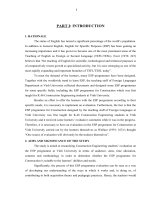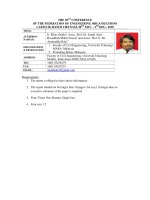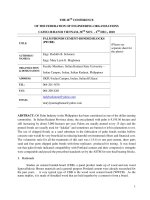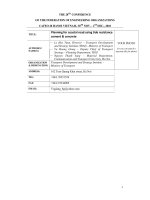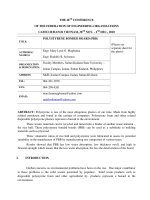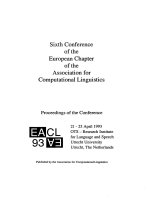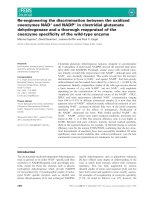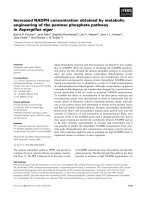THE 28TH CONFERENCE OF THE FEDERATION OF ENGINEERING ORGANIZATIONS
Bạn đang xem bản rút gọn của tài liệu. Xem và tải ngay bản đầy đủ của tài liệu tại đây (80.8 KB, 10 trang )
THE 28
TH
CONFERENCE
OF THE FEDERATION OF ENGINEERING ORGANIZATIONS
CAFEO 28, HANOI VIETNAM, 30
TH
NOV. - 2
ND
DEC., 2010
TITLE:
AUTHOR(S)’
NAME(S):
Ir. Ellias Saidin
2
, Assoc. Prof. Dr. Ismail Atan
1
,
Rosadibah Mohd Towell
1
and Assoc. Prof. Ir. Dr.
Aminuddin Baki
1*
ORGANIZATION
& DESIGNATION:
1. Faculty of Civil Engineering, Universiti Teknologi
MARA, Malaysia
2. Perunding Ikatan, Malaysia
ADDRESS:
Faculty of Civil Engineering, Universiti Teknologi
MARA, Shah Alam 40450, MALAYSIA
TEL:
+603 55436179
FAX:
+603 55435275
EMAIL:
Requirements:
1. The report is obliged to have above information
2. The report should not be longer than 10 pages (A4 size); if longer then an
executive summary of the paper is required.
3. Font: Times New Roman, Single line,
4. Font size: 12
Rainwater Harvesting as an Alternative Water Resources with Potential Flood Reduction
CAFEO28
2
RAINWATER HARVESTING AS AN ALTERNATIVE WATER RESOURCES
WITH POTENTIAL FLOOD REDUCTION
Ellias, S.
1
, Atan, I.
2
, Mohd Towell, R.
2
and Baki, A.
2*
1. Perunding Ikatan, Malaysia
2. Faculty of Civil Engineering, Universiti Teknologi MARA, Shah Alam
* Corresponding author:
ABSTRACT
In any building, there are demands for water, for various usages: domestic use, commercial use, industrial
use and fire protection use. Ability to be close to being self-sufficient on water resources would render the
building to be sustainable in terms of water resources. In order to be self-sufficient, alternative water
resources should be utilised instead of relying on public water supply. One of the alternative is rainwater
harvesting. Rainwater has the quality to be used for various purposes including cleaning, toilet flushing
and gardening, which can be up to 38% of total water consumption. If rainwater harvesting can be
implemented in significant number of buildings the demand for treated public water supply will only be
limited to drinking water and direct contact usage, such as showers and cooking. This will reduce the
demand for public water supply and the development can become sustainable in terms of water resources.
Another added benefit of rainwater harvesting is the potential reduction in flood peaks. If rain that fell on
the roof can be captured for rainwater harvesting purposes, then significant quantities of rain water will not
reach the waterways. This will reduce the runoff generated from the rainfall.
KEYWORDS: Flood reduction, Rainwater harvesting, Water resources
1.0. INTRODUCTION
Urban population worldwide has exceeded the rural population (UNEP, 2009). Cities are
considered as artificial ecosystems, in terms of water and energy flows. Around the
world rainwater harvesting has been promoted for alternative water supply as well as for
flood peaks attenuation.
In Australia, rainwater harvesting has been utilised to overcome the problems of water
scarcity (UNEP, 2009). In Jakarta, Indonesia, rainwater harvesting has been used to
reduce health impacts of flooding by providing cleaner alternative water resources
(Wilandari and Sirait, 2008). Rockström (2002) promoted the implementation of
rainwater harvesting in agriculture sector, which itself has very high demand for water.
Implementation of rainwater harvesting will reduce the demand for fresh water in
agriculture sector. This was also supported in studies by Mohamed et al. (2010). GDRC
(2010) reported several success stories on rainwater harvesting including: about 28-30%
of water demand can be met by rainwater harvesting in Singapore; about 750 buildings in
Tokyo implemented rainwater harvesting; rainwater harvesting systems had been
implemented in Berlin since 1998; and there are many other examples around the world.
In short, rainwater harvesting has been proven to be successful in many parts of the
world.
In any buildings in the urban areas, there are demands for water, for various usages:
domestic use, commercial use, industrial use and fire protection use. Ability to be close
to being self-sufficient on water resources would render the building to be sustainable in
Rainwater Harvesting as an Alternative Water Resources with Potential Flood Reduction
CAFEO28
3
terms of water resources. In order to be self-sufficient, alternative water resources should
be utilised instead of relying on public water supply.
It is not economical to use potable quality water just to flush the toilets. At the source,
grey-waters from households can be filtered and reuse for toilet flushing (Baki et al.,
2009). The other alternative would be rainwater harvesting (Ellias and Baki, 2010).
This paper however, will only focus on rainwater harvesting, as an alternative water
resources for toilet flushing and general cleaning. Another potential benefit of rainwater
harvesting, namely, flood peaks attenuation will also be discussed.
2.0.
RAINWATER HARVESTING
2.1. As alternative Water Resources
The practice of Rainwater Harvesting (RWH) is making a comeback in developed society after it
had almost completely surpassed by the modernisation of piped water supply (Ellias, 2009). The
age old technique of capturing or trapping rainwater on roofs or some other surface before it
touches the ground and storing it for reuse had been practiced since ancient civilizations. Roman
villas and Indian forts have been discovered to have installed large rainwater storage tanks below
and above ground (Pacey and Cullis, 1986). The rainwater was used for agricultural and domestic
consumption.
In rural areas in Malaysia, the practice of storing rainwater was discouraged with the
implementation of government development policy to supply reticulated treated water to rural
areas. It was also reported that rainwater were used in schools, mosque and community centres
until by policy, new public buildings then were connected to existing reticulated supplies ( Uzir
and Hamidon, 1991).
The capture and utilisation of rainwater is the most sustainable practice of alternative water
supply (Ellias and Baki, 2009). Abundant amount of energy and materials used to physically and
chemically treat the raw water and then transport it for long distances from where it falls, only to
be used for toilets flushing, general cleaning and gardening in the home; whereas rainwater can
be harvested and used at source where it falls. With basic screens and first flush diverters, quality
water is available with less damage to the environment from chemicals, greenhouse gases and
destruction of forest and biodiversity (Ellias and Baki, 2010).
From a typical consumption in a household in Malaysia (Baharuddin, 2007), 55% of the total
daily consumption may be substituted with rainwater i.e.; toilet flushing (30%), laundry (13%),
outdoor use (7%) and general cleaning (5%). To encourage domestic RWH practices, the
government has to introduce incentives in the form of grants, subsidies or tax returns for new
installations or retrofitting and acknowledge the quantum as costs to environmental damage.
The sustainable practice of RWH is further enhanced when it was estimated (Pidwirny, 2006.)
that the hydrologic cycle time for rainwater is about nine days as contrasted to the cycle time of
groundwater which can be 100 years for shallow wells and up to 10,000 years for deep wells.
This means that the water molecule in rainfall is being used many times over than say the
groundwater molecule. In cities with groundwater supply, water is not being replenished fast
enough resulting in receding groundwater levels and shortages.
Rainwater Harvesting as an Alternative Water Resources with Potential Flood Reduction
CAFEO28
4
Ellias (2009) studied three houses in Selangor and found that rainwater has contributed
about 38.5% of total water consumption in a residence. This can be translated into water
supply conservation efforts to reduce the demand on the existing public water supply
system. These three houses can be considered sustainable in terms of water resources.
2.2. Potential Volumes
The potential for rainwater harvesting in terms of water volume can be illustrated by
assessing the rainfall for that area. Table 1 shows the rainfall amount and potential
storage volume for a school in Shah Alam City in Selangor, Malaysia. Figure 1 shows
the location of Shah Alam. The average annual rainfall is about 2200mm, indicating
good potential volume of rainwater can be captured in this city. Table 1 indicates that the
potential monthly storage of 53 m
3
can be achieved for this school.
Table 1: Rainfall for Shah Alam
(Source: Ahmad, 2007)
Catchment Area (km
2
)
290.3
Total Rainfall (mm)
119372.0
Total Storage (L)
34653692.0
Average Annual Rainfall (mm)
2220.7
Average Annual Storage (L)
644665.1
Average Monthly Rainfall (mm)
185.1
Average Monthly Storage (L)
53734.5
Figure 1: Location of Shah Alam (Source: Dromoz, 2010)
Rainwater Harvesting as an Alternative Water Resources with Potential Flood Reduction
CAFEO28
5
AVERAGE RAINFALL FROM 1943 - 2007
0
500
1000
1500
2000
2500
3000
3500
1943
1948
1953
1958
1963
1968
1973
1978
1983
1988
1993
1998
2003
TIME (YEAR)
RAINFALL (mm)
ANNUAL
AVERAGE = 2220.69 mm
Figure 2 shows the annual rainfall patterns, which fluctuated over the years. The annual
rainfall is ranging from zero to 3200mm with an average of about 2200mm. Figure 3
shows the potential average monthly storage of rainwater. The monthly storage volume
is ranging from 33m
3
to 84m
3
with an average of 53m
3
. These amount of water stored
definitely will not be able to meet the total water demand in the school. However,
rainwater harvesting should be aimed at meeting the demand for toilet flushing and
general cleaning, so that treated water need not be used for those purposes.
Figure 2: Annual and average rainfall for Shah Alam
(Source: Ahmad, 2007)
